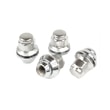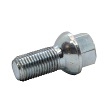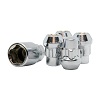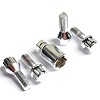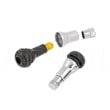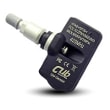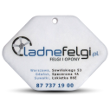How to read tire markings?
Symbols on tires indicate their size, load capacity, speed rating, seasonality, and production date. Thanks to them, you can choose the right model for your car and driving conditions. This is the foundation of safe use. In this article, we will explain all the issues related to tire markings.
Tire markings – what do the symbols on the sidewalls mean?

Table of Contents:
- Tire size – the basis of fitment
- Load and speed indices
- Tire construction – what is a modern tire made of?
- Homologations and manufacturer symbols – what do AO, MO, N0... mean?
- Tire type and seasonal markings – when and where to use
- Additional technical markings
- Key technologies used in modern tires
- How to check tire age? – DOT
- Tire construction type – radial or diagonal?
Tire size – the basis of fitment
The most visible marking on the tire is its size, e.g. 225/45 R17 94W. What do these numbers and letters mean?

The tire size is a basic piece of information found on the tire's sidewall. These markings provide us with a lot of data about the physical dimensions of the tire and its operating parameters. Understanding this notation helps avoid mistakes when buying and ensures optimal driving characteristics.
- 225 – tire width in millimeters
- 45 – aspect ratio, the percentage ratio of sidewall height to width (here: 45% of 225 mm)
- R – radial construction (currently standard in most tires)
- 17 – rim diameter in inches
- 94 – Load index (here: 670 kg per tire)
- W – speed index (here: up to 270 km/h)
Select a tire for your rim width
📊 Tire Load Index Table
The load index indicates the maximum load that a single tire can carry at the maximum permissible pressure. The higher the index, the greater the tire's load capacity. It’s important to note: the specified value applies only when the tire is fully inflated and refers to static load, such as driving straight on a flat surface. The load index must not be lower than specified by the vehicle manufacturer
| Load index | Maximum load(kg) |
|---|---|
| 20 | 80 |
| 21 | 85 |
| 22 | 90 |
| 23 | 95 |
| 24 | 100 |
| 25 | 106 |
| 26 | 112 |
| 27 | 118 |
| 28 | 125 |
| 29 | 132 |
| 30 | 140 |
| 31 | 148 |
| 32 | 156 |
| 33 | 165 |
| 34 | 175 |
| 35 | 185 |
| 36 | 195 |
| 37 | 206 |
| 38 | 218 |
| 39 | 230 |
| 40 | 243 |
| 41 | 257 |
| 42 | 272 |
| 43 | 287 |
| 44 | 300 |
| 45 | 315 |
| 46 | 330 |
| 47 | 345 |
| 48 | 365 |
| 49 | 387 |
| 50 | 400 |
| 51 | 412 |
| 52 | 425 |
| 53 | 437 |
| 54 | 450 |
| 55 | 462 |
| 56 | 475 |
| 57 | 487 |
| 58 | 500 |
| 59 | 515 |
| 60 | 530 |
| 61 | 545 |
| 62 | 560 |
| 63 | 580 |
| 64 | 600 |
| 65 | 615 |
| 66 | 630 |
| 67 | 650 |
| 68 | 670 |
| 69 | 690 |
| 70 | 710 |
| 71 | 730 |
| 72 | 750 |
| 73 | 775 |
| 74 | 800 |
| 75 | 825 |
| 76 | 850 |
| 77 | 875 |
| 78 | 900 |
| 79 | 925 |
| 80 | 950 |
| 81 | 975 |
| 82 | 1000 |
| 83 | 1030 |
| 84 | 1060 |
| 85 | 1090 |
| 86 | 1120 |
| 87 | 1150 |
| 88 | 1180 |
| 89 | 1215 |
| 90 | 1250 |
| 91 | 1285 |
| 92 | 1320 |
| 93 | 1360 |
| 94 | 1400 |
| 95 | 1450 |
| 96 | 1500 |
| 97 | 1550 |
| 98 | 1600 |
| 99 | 1650 |
| 100 | 1700 |
| 101 | 1750 |
| 102 | 1800 |
| 103 | 1850 |
| 104 | 1900 |
| 105 | 1950 |
| 106 | 2000 |
| 107 | 2060 |
| 108 | 2120 |
| 109 | 2180 |
| 110 | 2240 |
| 111 | 2300 |
| 112 | 2360 |
| 113 | 2430 |
| 114 | 2500 |
| 115 | 2575 |
| 116 | 2650 |
| 117 | 2725 |
| 118 | 2800 |
| 119 | 2900 |
| 120 | 3000 |
| 121 | 3075 |
| 122 | 3150 |
| 123 | 3250 |
| 124 | 3350 |
| 125 | 3450 |
| 126 | 3550 |
| 127 | 3650 |
| 128 | 3750 |
| 129 | 3850 |
| 130 | 3950 |
| 131 | 4050 |
| 132 | 4150 |
| 133 | 4250 |
| 134 | 4350 |
| 135 | 4450 |
| 136 | 4550 |
| 137 | 4650 |
| 138 | 4750 |
| 139 | 4850 |
| 140 | 4950 |
| 141 | 5050 |
| 142 | 5150 |
| 143 | 5250 |
| 144 | 5350 |
| 145 | 5450 |
| 146 | 5550 |
| 147 | 5650 |
| 148 | 5750 |
| 149 | 5850 |
| 150 | 5950 |
- Speed Index indicates the maximum speed a tire can maintain at its rated load. For example:
- H = 210 km/h
- V = 240 km/h
- W = 270 km/h
- Y = 300 km/h
Tire Construction – What is a Modern Tire Made Of?
At first glance, a tire may look like a solid piece of rubber, but in reality, it’s a complex engineering structure. Its layers and components perform various roles – from providing grip to protecting against overload and mechanical damage. Discover the construction of a tire and see how it relates to the markings found on its sidewall.

1. Tread – contact with the road
This is the outer layer of the tire that comes into direct contact with the road surface.
- Provides traction, channels water away, and protects against aquaplaning.
- Special markings on the tire, such as M+S (Mud and Snow) or 3PMSF (three-peak mountain snowflake symbol), refer to the properties of the tread.
- In the tread grooves, there are small rubber bridges – when they are level with the tread surface, it means the tire has reached its minimum allowable tread depth.
2. Belt – the steel reinforcement
Beneath the tread of every modern tire lies a crucial component of its construction: the belt. It typically consists of steel cords embedded in rubber, arranged at an angle relative to the direction of travel. In some tires, especially lightweight motorcycle or performance models, textile belts made of aramid (Kevlar) or nylon fibers are also used.
- Provides the tire with lateral rigidity and ensures stability at high speeds.
- The belt prevents deformation and minimizes heat build-up during driving.
- Thanks to the steel belts, the tire can carry higher loads without deforming, which increases its load capacity.
- Helps maintain a constant tire shape, reducing rolling resistance and contributing to lower energy loss and fuel consumption.
3. Carcass Cord – the skeleton of the tire
The cord is a layer of textile fabric that forms the tire’s skeleton and provides mechanical strength. It gives the tire its shape and allows it to withstand the immense forces generated during driving. In modern passenger car tires, cords are made of polyester, nylon, or aramid (Kevlar) fibers, while truck tires may also use steel cords for added durability and load-bearing capacity.
- Ensures strength and flexibility, allowing the tire to absorb road irregularities.
- In radial tires, the cords are arranged radially (denoted by the letter R on the tire).
- The number of cord layers (called plies) directly affects the tire’s load index.
- A typical passenger tire usually has one cord layer, while off-road or truck tires may have multiple layers.
- The durability of the tire also depends on the cord – damage (e.g., cuts or excessive flexing) can lead to bulges on the sidewall, which are dangerous and require immediate tire replacement.
4. Bead Wire – securing the tire to the rim
The bead wire is a steel wire embedded in rubber, reinforcing the edge of the tire. It’s located in the so-called bead area and plays a vital role in maintaining an airtight seal and ensuring the tire remains securely seated on the wheel rim. The bead wire prevents the tire from slipping off the rim, even under high lateral loads, sudden maneuvers, or pressure changes.
- Ensures a tight and stable fit of the tire on the rim.
- In Run Flat tires, the bead wire is additionally reinforced.
- Prevents the tire from unseating during low-pressure driving or sharp cornering.
5. Sidewalls – protection against damage
The sidewalls are the flexible sections of the tire between the tread and the bead. Although they do not contact the road surface, they play a critical role in daily use: protecting the tire from lateral impacts, providing structural flexibility, and influencing ride comfort. Their construction combines rubber layers and cords that must withstand dynamic stresses and occasional contact with curbs or debris.
- Protect against side impacts and improve ride comfort.
- Sidewalls display key information such as tire size, load index, speed rating, production date (DOT code), and designations like XL (Extra Load).
- They allow the tire to flex over bumps, contributing to smoother driving.
6. Bead – the tire’s connection to the rim
The bead ensures an airtight seal between the tire and the wheel rim.
- The bead is a reinforced part of the tire’s structure located at the interface with the rim. Its main function is to maintain an airtight fit and provide stability under driving forces. The bead allows tubeless tires to hold air and safely transfer lateral forces during cornering, acceleration, and braking.
The bead consists of:
- Bead wire: a steel wire embedded in rubber that provides structural rigidity and mechanical strength.
- Rubber core: a flexible rubber layer surrounding the bead wire, allowing easy mounting onto the rim.
- Textile reinforcements: providing extra resistance to bending and compression.
In Run Flat tires (RFT), the bead is further reinforced to prevent unseating from the rim when driving with low or zero pressure. Similarly, in tires marked XL (Extra Load), the bead’s construction is more robust to handle higher loads.
7. Inner Liner
The inner liner is a thin but crucial layer in modern tubeless tires. Its job is to retain air within the tire and maintain a perfect seal without the need for a traditional inner tube. Thanks to this layer, contemporary tires are lighter, more resistant to damage, and easier to maintain.
- Made of a rubber compound with very low permeability (usually butyl), it prevents air loss through microscopic pores in the tire structure.
- In tubeless tires, there is no separate inner tube – the inner liner fulfills its role by sealing tightly against the bead and rim.
- Protects the carcass from moisture and air, which could cause corrosion of the tire’s steel components (e.g., the belts).
Modern tubeless tires with an inner liner have gradually replaced older tube-type designs because they offer several key advantages. In the event of a puncture, the risk of sudden air loss is significantly reduced as air escapes more slowly than in tube-type tires, improving driving safety. Additionally, tubeless tires can be used with sealant fluids that automatically plug small punctures, allowing the driver to continue their journey without immediate repair. This design eliminates the need for a separate tube, making the entire wheel assembly lighter, which improves fuel efficiency and reduces rolling resistance.
Why Should You Know Tire Construction?
Understanding how a tire is built is more than just a technical curiosity – it’s practical knowledge that directly affects driving safety and comfort. Knowing the different layers and components of a tire helps you appreciate how they work together to provide grip, stability, and durability. This knowledge allows drivers to choose tires that best suit their driving style, the type of roads they travel on, and their vehicle’s technical requirements. The markings on a tire’s sidewall are not random – they indicate the construction of the carcass, load and speed ratings, and technologies like reinforced sidewalls or Run Flat capabilities. Understanding these symbols and their relation to tire construction makes it easier to avoid mistakes when buying tires and ensures proper use and maintenance. This, in turn, results in longer tire life, lower fuel consumption, and greater safety in everyday driving.
Homologations and manufacturer symbols – what do AO, MO, N0... mean?
When buying new tires, we often come across mysterious markings on the sidewalls – such as AO, MO, N0, RO1, or K1. What do they mean? These are manufacturer homologations – confirmation that the tire has been developed or tested specifically for a particular car brand and model.
✅ What do the most popular tire homologation symbols mean?
Check how to interpret markings like AO, MO, N0, or K1. These symbols indicate that the tire was designed or tested for specific car manufacturers.
| Symbol | Car Manufacturer | Homologation Description |
|---|---|---|
| AO / AO1 | Audi | Audi Original – tailored to Audi suspension and safety systems |
| MO / MOE | Mercedes-Benz | Mercedes Original (Extended) – also with Run Flat technology |
| N0 / N1 / N2… | Porsche | Porsche homologation – number indicates tire generation |
| RO1 / RO2 | Audi quattro / RS | Tires for quattro drive and Audi RS sports models |
| K1 / K2 | Ferrari | Special versions tailored for Ferrari sports cars |
| BMW* / * | BMW / MINI | Star-marked tires – dedicated to BMW suspension and traction |
| J / JLR | Jaguar / Land Rover | Premium homologations for JLR SUVs and limousines |
| T0 / T1 | Tesla | Versions optimized for EVs – often with noise reduction foam |
Why does it matter?
Homologated tires feature different rubber compounds, carcass constructions, or tread patterns tailored to the needs of a particular car model. Sometimes the differences are cosmetic, but often they significantly affect:
- braking distance
- tread wear
- compatibility with suspension and vehicle electronics
If you own a Porsche 911, BMW M3, or Audi RS – it’s definitely worth choosing tires with the appropriate marking to ensure full performance and safety.
In our experience, we’ve seen cases where one axle had tires with, for example, N0 homologation, while the other had no marking or a different one, like MO. Theoretically, they matched in size but differed in performance characteristics – which in cars like the Porsche 911 can affect handling and traction systems.
Therefore, we always recommend fitting tires with the same homologation on both axles (front and rear) – even if the vehicle manufacturer doesn’t explicitly require it. It’s a simple way to avoid unexpected vehicle behavior – especially during dynamic driving.
✅ Is it always worth buying homologated tires?
- If you own a premium vehicle (Audi S/RS, BMW M, Mercedes AMG, Porsche) – definitely yes.
- For city cars you can consider non-homologated options – but always make sure the tire meets all required specifications (size, load and speed indices, construction type).
Tire type and seasonal markings – when and where to use?
Not all tires are universal. Depending on weather conditions and driving style, you should choose the appropriate tire type. Manufacturers use clear seasonal markings:

- M+S (Mud + Snow) – tire suitable for muddy and snowy conditions. It can be a winter or all-season tire, but does not always meet true winter tire standards.
- 3PMSF (Three Peak Mountain Snowflake) – a snowflake symbol on a mountain background. This is official winter certification – the tire has been tested for snow performance.
- All Season / 4-Seasons – all-season tire combining summer and winter features. Suitable for moderate climates and drivers with lower mileage.
- Summer / Winter – simple season indication. Summer tires should not be used in winter, while winter tires lose grip on dry summer roads and wear out faster.
Remember that in some countries (e.g., Germany, Austria), driving in winter without tires marked with 3PMSF may result in a fine – even if the tire has M+S marking.
Additional technical markings
In addition to basic size and seasonal data, tires also feature additional technical markings indicating construction, reinforcements, and mounting direction:
- XL (Extra Load) – tire designed for higher loads. Recommended for SUVs, station wagons, and utility vehicles.
- RF (Reinforced) – indicates reinforced construction. Often used interchangeably with XL.
- Tubeless (TL) – tubeless tire. Standard today – more airtight, safer, and easier to service.
- Rotation / Directional – indicates rolling direction. Important during installation – incorrect mounting reduces grip.
- Asymmetrical / Inside / Outside – tire with asymmetrical tread. Clearly marked inner and outer sides.
- Run Flat – allows driving after a pressure loss (usually up to 80 km at reduced speed).
(Incorrect installation of directional or asymmetrical tires can lead to faster wear, poorer traction, and even reduced safety on wet surfaces.)

EU tire label – what does it mean and why check it?
In addition to technical markings on the tire sidewalls, every new tire sold in the European Union must have an EU label. This is a sticker or store information (also online), showing three key performance parameters:
- Fuel efficiency (rolling resistance) – affects fuel consumption.
- Wet grip – directly related to safety.
- External noise level – measured in decibels and classified alphabetically.
Since 2021, labels may also include markings for winter tires (3PMSF) and ice grip (Ice Grip), if the manufacturer foresees such use. Thanks to the EU label, you can quickly compare tires not only by appearance or tread but also by real road performance. Remember – every new tire in the EU must have an EU label and product sheet, and their absence may indicate illegal import or seller error.
Key technologies used in modern tires
Modern tires are more than just rubber and tread – they are advanced engineering products utilizing innovative solutions to improve comfort, performance, and safety. Here's an overview of key technologies worth knowing before purchasing a set of tires.
Run Flat tire – what does it mean and how does it work?
Run Flat is a technology that allows continued driving even after a complete loss of pressure. This is possible thanks to specially reinforced sidewalls that support the vehicle's weight. In other words – even if you get a flat tire, you can still drive about 80–100 km at a speed of up to 80 km/h without risking immediate vehicle immobilization.
Run Flat tires have various designations depending on the manufacturer:
- RFT – Run Flat Tire (Bridgestone, Dunlop)
- SSR – Self Supporting Runflat (Continental)
- ZP – Zero Pressure (Michelin)
- EMT – Extended Mobility Tire (Goodyear/Dunlop)
- ROF – Run On Flat (Goodyear)
- MOE – Mercedes Original Extended (for Mercedes models)
🚗 Run Flat vs. conventional tire – comparison
Check the key differences between Run Flat and traditional tires. This table will help you consciously choose the right solution for your car.
| Feature | Run Flat Tire | Conventional Tire |
|---|---|---|
| Ability to drive after a puncture | ✅ Yes (up to 80 km at reduced speed) | ❌ No |
| Need for a spare wheel | ❌ Not needed | ✅ Yes (or a repair kit) |
| Tire weight | Heavier | Lighter |
| Ride comfort | Slightly lower (stiffer sidewalls) | ✅ Better |
| Price | Higher | Lower |
| Repairability after puncture | ❌ Usually not | ✅ Often yes |
Not every rim is suitable for Run Flats. The best options are rims with a protective flange and TPMS sensors – they detect pressure loss, as the driver may not feel the difference on stiffer tires.
PNCS - Pirelli Noise Cancelling System
PNCS (Pirelli Noise Cancelling System) is a technology used in Pirelli tires, featuring a special sound-absorbing foam inside the tire, significantly reducing cabin noise – by 2–3 decibels – improving ride comfort, especially in electric and premium cars.
Seal Inside / ContiSeal
Seal Inside is a self-sealing technology used by Pirelli, featuring a special sticky layer inside the tire that automatically seals punctures (e.g., from a nail), allowing you to continue driving without pressure loss and without having to stop immediately.
MultiGrip (or Dual Compound)
MultiGrip is a technology mainly used in sport tires, employing different rubber compounds within one tire – harder in the center for durability and softer on the shoulders for better cornering grip and dynamic driving.
NanoPro-Tech
NanoPro-Tech is a Bridgestone-developed rubber compound technology with nano-particles, reducing rolling resistance, improving fuel efficiency, and providing excellent grip – especially on wet surfaces.
Modern tire technologies are more than marketing slogans – they offer real solutions impacting comfort, safety, and vehicle performance. Whether you seek quieter rides, longer durability, better grip, or puncture resistance – it’s worth paying attention to applied technologies and choosing tires that fit your driving style and car type.
How to check tire age? – DOT

Tire age is very important – even if unused, tires may lose their properties after a few years. Production date information can be found in the DOT code, where the last four digits indicate the week and year.
Example:
- DOT XXXX XXXX 0413
– this means the tire was manufactured in the 4th week of 2013, i.e., late January or early February 2013.
If the tire shows only a three-digit code (e.g., 079) – it means the tire is from before the year 2000 and should definitely no longer be used.
How old can a safe tire be?
- It’s recommended to not use tires older than 6 years, even if they appear new and were stored well.
- 10 years from the production date is the absolute maximum – after this, the rubber hardens and loses its driving properties, even if the tread looks good.
Tire construction type – radial or diagonal?
Tires may feature a letter marking for internal construction type:
- R – radial tire. Currently the standard construction type, where carcass layers run radially from bead to bead. Provides greater comfort, better grip, and durability.
- D or no marking – diagonal (bias-ply) tire (now very rare). Mainly used in agricultural machinery or motocross.
Summary
Reading tire markings is a basic skill for every driver. It allows you to consciously choose the right tires for your car, driving style, and road conditions. Understanding symbols is not just a technical matter – it’s a guarantee of safety, comfort, and tire durability.
Don’t buy tires “by guess” – read, analyze, and choose wisely. It’s an investment not only in durability but most importantly in safety.




 Modern design
Modern design Perfect fit
Perfect fit High durability
High durability Free shipping within 24 hours
Free shipping within 24 hours
 Individual project
Individual project Dedicated caregiver
Dedicated caregiver
